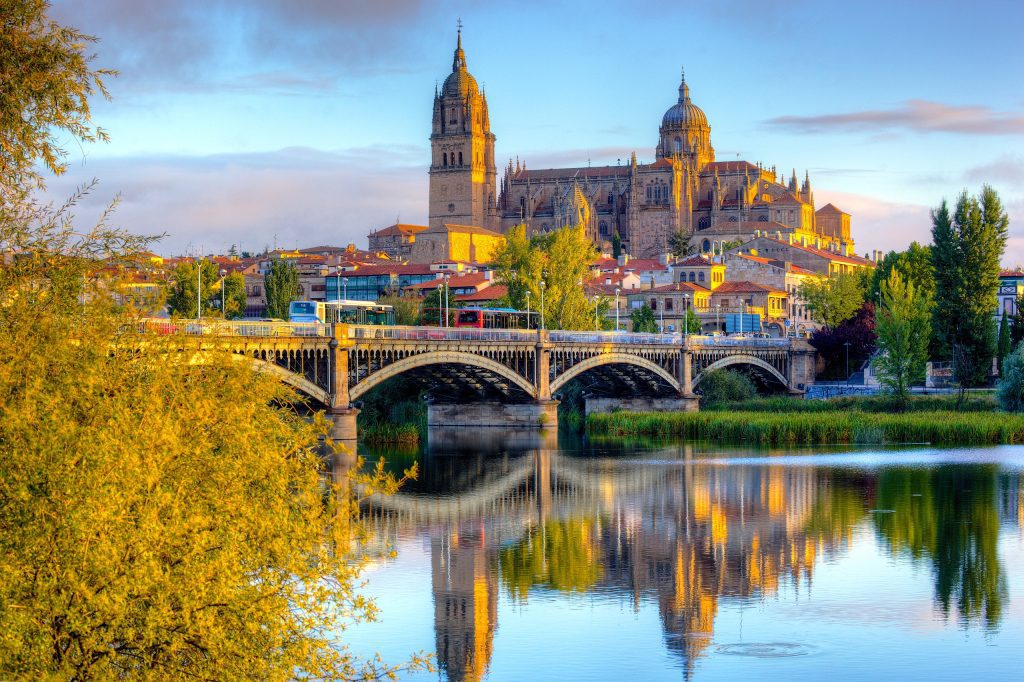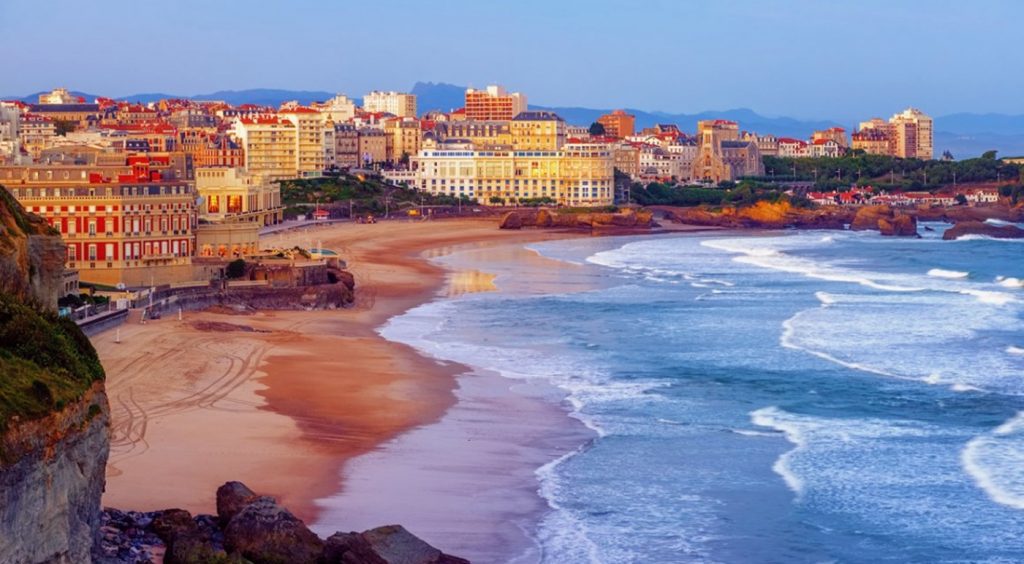Call us now (+1) 646-693-8373
| Destinations | Contact Us |
Call us now (+1) 646-693-8373
| Destinations | Contact Us |
Call us now (+1) 646-693-8373
| Destinations | Contact Us |
Spain Tours and Guided Trips – Are you looking for a memorable vacation in Spain? Look no further than Eskapas Travel! With world-class art and architecture, stunning natural treasures and fabulous food, it’s no wonder Spain is one of the world’s great tourist destinations. With so many things to do during your trip to Spain, you may want to hold off on those afternoon siestas.
Our team of experienced travel experts will help you discover the treasures of this beautiful country. From the medieval architecture of Madrid to the idyllic landscapes of Porto, our tours are designed to give you an authentic Spanish experience.
If you want to discover the real Spain, we would definitely recommend that you take one of our guided package tour. At Eskapas Travel, we believe that travel should be an adventure. That’s why we offer a range of tours and packages that cater to all your travel needs. Whether you’re looking for a city break, island hopping, or a private tour, we’ve got you covered.
One of them is for you!
Didn’t you find your perfect vacation package? No worries, use our convenient search and filter options, tailor-making a journey that captures World’s unique beauty and rich heritage just for you.
It all depends on where you’re flying from, but most people fly into one of Spain’s main airports, as it’s usually the fastest way to get to Spain. The biggest airports in Spain are Barcelona (Barcelona-Barcelona Airport), Madrid (Málaga-Málaga Airport), and Mallorca (Mallorca-Barcelona Airport).
Direct flights to Spain are available from major US, Canadian, Australian, and Indian cities. The length of the flight varies depending on the departure city and the airline. For instance, a New York-to-Madrid flight takes approximately 7 hours, 30 minutes.
Round-trip airfare to Spain can cost between 500 and 1,500 dollars, depending on the season and your destination.
Accommodation costs in Spain can range between $50 and $500 a night, depending if you want to stay in a budget hotel or a luxury hotel.
Spain has a well-developed and efficient public transport system. A one-way metro or train ticket in Spain can cost between 1.50 and 3.50 dollars.
 Food costs in Spain can be between $10 and $50 a person, depending on if you choose a budget restaurant or a mid-range restaurant.
Food costs in Spain can be between $10 and $50 a person, depending on if you choose a budget restaurant or a mid-range restaurant.
Costs in Spain for budget travelers can be between US$80 and US$100 a day, while those in mid-range travel can spend between $100 and $200 a day.
Before planning your trip, it’s important to do some research on activities and costs so you can create a travel budget that works best for you.
Spain has something for everyone: whether you have a couple of days to spare for a quick city trip, or you’re thinking of spending three weeks exploring the country, Spain has something for everyone.

10-16 days is the best time to explore 2 regions or cities, with enough time left over to explore rural neighborhoods, such as Barcelona’s Catalonia coast or Cordoba, an Andalusian town two hours north from Granada.

At the very least, we suggest a minimum of 8 days for Spain itineraries, as this is sufficient time to visit 2 destinations in 1 trip (for example, Madrid and Barcelona or Seville & Granada).
If you have two to 3 weeks in hand, you can explore the depths of whole Iberian Peninsula as Madrid, Porto, Lisbon, Barcelona or Valencia, or choose to combine multiple destinations in one epic Spain itinerary.
Spain is a country with a rich history and culture, and there are many things to do and see. Here are some of the top attractions and activities to consider:
Visit the Alhambra in Granada: This stunning palace and fortress complex is a UNESCO World Heritage Site and one of Spain’s most popular tourist attractions. It’s a must-visit for anyone interested in history, architecture, or art.
Explore the City of Arts and Sciences in Valencia: This futuristic complex is home to a planetarium, an opera house, an aquarium, and more. It’s a great place to learn about science and technology while enjoying some of the best views in the city.
Relax on the beaches of the Balearic Islands: These islands are known for their beautiful beaches, crystal-clear waters, and vibrant nightlife. They’re a great place to unwind and soak up the sun.
Take a walking tour of Madrid: Madrid is the capital of Spain and home to many historic landmarks, museums, and galleries. A walking tour is a great way to explore the city and learn about its rich history and culture.
Visit the Sagrada Familia in Barcelona: This iconic basilica is one of the most famous landmarks in Spain. It’s a masterpiece of modernist architecture and a must-visit for anyone interested in art and design.
Attend a flamenco show in Seville: Flamenco is a traditional Spanish dance that originated in Andalusia. Seville is one of the best places to see a flamenco show and experience this vibrant and passionate art form.
Try the local cuisine: Spain is known for its delicious food and wine. Be sure to try some of the local specialties, such as paella, tapas, and Rioja wine.
These are just a few of the many things to do and see in Spain. Whether you’re interested in history, art, culture, or food, there’s something for everyone in this beautiful country. Enjoy your trip!
The best time to tour Spain is late spring and early fall. May and September are popular, but April and October are also popular. The weather is mild across the country, especially in May. It is not too hot as it is in summer in southern Spain, and it is not too cold and damp as it is in the north and Basque country. The tourist crowds are light, although this is more apparent in the autumn, and you can get good deals on hotels and flights (although less likely in the region of the Basque).
Spain is open to you for cultural events such as Easter ferias and flamenco, as well as sherry tastings and outdoor activities such as hiking and beach trips. No part of the country is closed.
Although Spain is known for its warm and mild weather, the country is large and has a diverse landscape, so the weather can vary depending on where you are.
The Pyrenees, Castile, and Leon are among the coldest regions in Spain, with average winter temperatures ranging from 30 °C (-1 °F) to 40 °C (4 °F).
In Andalusia, one of Spain’s warmest regions, temperatures can reach up to 100 °C (38 °F) in the summer and attract beach-goers to the costas del sol, costas del solo, and the balearic islands.
No matter where you’re going, it’s best to pack a sweater, light jacket and umbrella for fall and winter and shorts, t-shirts and a hat for summer. In summer, the south and east beaches, resorts and big cities such as Barcelona will be busy, but smaller towns and cities can be quiet all year round.
If you’re looking for a break from the tourist crowds, winter can be a great time to get away from the crowds and book up a place to stay in the Costa del sol or Costa Blanca. The cold weather makes you feel more at home and you can take part in winter sports like skiing in Pyrenees or Sierras, or celebrate Christmas.
Spain’s style is a mix of contemporary and chic, with conservative silhouettes and colors. While Spain doesn’t have a strict dress code, it’s important to dress according to the occasion and location. Here are a few tips to help you choose the right outfit:
Look smart: Spaniards pride themselves on their appearance and look great no matter the time of year. Don’t wear anything cheap or dirty, especially if you’re visiting style-savvy cities like Madrid or Barcelona.

Keep it classy: The Spanish don’t usually wear mini-skirts or short dresses, and they usually only wear swimwear on the beach.
Dress according to the season: Spaniards dress according to the seasons, not according to the weather. So if it’s hot in spring, don’t be surprised to see locals wearing jeans and a jacket.

Wardrobe staples: Well-fitted denim is a must-have for any season, and you can easily layer it with a winter jacket. Classic button-downs and shirts are also a must-have.
Whether you need a visa to enter Spain depends on your nationality. Spain is a member of the Schengen Area, which allows citizens of many countries to enter its territory for tourism and business purposes without a visa.
Please check with the Spain embassy or consulate in your country to confirm the visa requirements as they can change and may vary depending on your specific situation.
Note:
US citizens do not need a visa to enter the Schengen Area for a short stay of up to 90 days for tourism or business purposes 12. However, US residents of other nationalities may or may not need a visa depending on their nationality 1. US residents coming from countries that have established visa-free regimes with the EU do not need to obtain a visa to enter Europe. On the other hand, US residents coming from countries that have not established a visa-free regime with the EU will have to apply for a Schengen visa in the US to enter any of these countries 1.
Starting from May 2025, US citizens will have to apply for an ETIAS prior to their travel towards Europe, in order to be allowed to enter the territory.
When traveling to the Schengen Area, US citizens must carry a US passport that is valid for at least three more months beyond its intended date of departure from the Schengen Area, an ETIAS authorization (starting from May 2025), and documents that show why the US citizen is traveling to the Schengen Area, as well as proof of sufficient financial means
Much more than flamenco and bullfights, Spain has everything from cutting-edge museums to quaint fishing villages, green highland valleys, soaring cathedrals, medieval towns, designer cuisine, spirited nightlife, and an immense treasury of painting and sculpture. At the hub of it all is Madrid, one of Europe’s liveliest capitals. It’s the seat of the Spanish government and a center for the national media.
Beyond the designer boutiques and chic restaurants, however, you’ll find a simple Castilian town. Life here is lived in cafés and rustic taverns. All it takes to become a local is to duck inside one. Barcelona, whose leafy streets are lined with stunning art nouveau and modernist architecture, rivals Madrid for power and is generally regarded as the winner in culture and style. Although both cities are exciting, most exciting for anyone vacationing in Spain is the nationwide insistence on enjoying life. On a trip here, you’ll no doubt catch that spirit, too.
Here are some resources to learn more about Spain:
Exploring the Flavors of Spain, Visiting the Prado Museum, Spain Must-See Destinations, What To Do, What To Eat and Where To Eat in Seville, The Light of Cáceres, Fascinating Medieval City, Prado Museum Madrid, Best Museums in Madrid, Best Things to Do in Spain, Top 5 Beaches in Spain, Granada Less Than 48 Hours, Best Boutique Hotels in Barcelona, Barcelona Less Than 48 Hours, Seville Less Than 48 Hours, Bilbao Less Than 48 Hours, Madrid Less Than 48 Hours, Free Things to Do in Madrid, Best Things to Do in Fatima, Best Things to Do in Aveiro, Best Things to Do in Lisbon, Best Things to Do in Porto, Batalha Monastery,
Madrid Short Break, Malaga Short Break, Bilbao Short Break, Seville Short Break, Granada Short Break, Cordoba Short Break, Barcelona Short Break, Andalusia and Toledo, Absolutely Spain
Grand Tour of Spain, Northern Spain and Galicia
Northern Spain, Southern Europe: Spain – France – Italy, Grand Iberian Adventure: Spain and Portugal, Northern Spain and Portugal, Spain, Portugal & Morocco, Spain and Morocco, Italy and Spain : A Mediterranean Dream, Spain and Portugal Highlights
The trip was really well-planned, with exactly the appropriate balance of free time and guided tour.
The itinerary was great and meticulously prepared. It enabled me to explore and discover a lot in only one week, and I had ample time to spend at each location I visited. Nicole was our tour guide. She was kind, compassionate, and informed. I wholeheartedly suggest this trip. I met some wonderful people in this trip and made some precious memories!!
